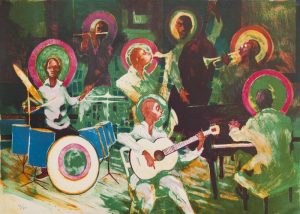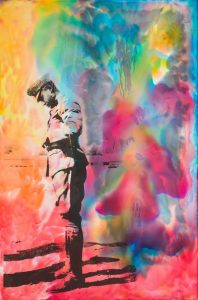Visual Narratives within Creative Art-Making
The early history of American art was highly influenced by the classical traditions of Western Europe, due to the fact that the overwhelming majority of colonists who settled in North America’s British colonies hailed from Western Europe and imposed the traditions and culture they knew in the new world. This was evident at the first American art museum and art school, the Pennsylvania Academy of the Fine Arts (PAFA), founded in 1808 in Philadelphia.
It was not until the last decade of the 19th century that a homegrown American art movement — the Ashcan School — emerged that broke firmly with the classical ideals of Western Europe. Associated with PAFA, the artists of the Ashcan School shifted focus away from upper-class life and its materialistic sensibilities and embraced a more egalitarian approach that illuminated the conditions of average working families and their lives.
During the beginning of art history in the U.S., very few Black artists were recognized by the dominant white society. Many of these artists — including David Bustill Bowser and Henry Ossawa Tanner — went west and painted landscapes or traveled to Europe where galleries and patrons were more receptive to their talents. This idea of relocating to develop one’s craft and find success resulted in several Black artists (singers, musicians, and writers) using the G. I. Bill to travel to Europe after the end of World War II.
It was not until the Civil Rights Movement of the 50s and 60s that Black artists began to find their own aesthetic interests and identity as artists and
It was not until the Civil Rights Movement of the 50s and 60s that Black artists began to find their own aesthetic interests and identity as artists and identity as artists from a particular ethnic group and experience. In 1963, the year of the famous March on Washington, the voice of the Black artists spoke to a collective consciousness with the formation of Spiral, a group that assembled in New York to develop a shared vision of what it meant to make art within the context of the Civil Rights Movement. This began conversations on the concept of a Black aesthetic as a challenge but also an assertion of their empowerment and desire to self-identify beyond an aesthetic based solely on race.
These two approaches and sensibilities among Black artists — one rooted in shared Black identity and the other emphasizing individual creative expression independent of a racial context — continue today as strong forces in how artists from oppressed communities use their art for protest and resistance. As a result, in contemporary art by people of color, we see a wide diversity of ideas borrowed from other cultures and personal experiences, which transform private narratives into accessible public information. As the country became more diverse during the latter part of the 20th century, Latinx, Asian and African immigrants became more present in American art.
The following artworks and related materials explore the psychological and emotional aspects of experiences such as love and family, pain and sorrow, faith and hope. The experiences and emotions these artworks relate to are distinguished by their authenticity — inspired by real life as
lived by the artist or someone they knew.
Related Artwork
Curriculum Connections
Suggested Topics for Portraiture (in studio art and art history education), Visual Narratives, and Expressive Writing
Portraiture (in studio art and art history education), Visual Narratives, Expressive Writing:
The use of words or a combination of words, symbols, and human images to convey deeply felt emotions.
Questions to Consider
Creative people — artists, musicians, dancers, and writers — often create new works bearing witness to the death of a loved one, especially when it is a tragic death or the result of a catastrophic event like an environmental or health disaster such as COVID-19.
- Art memorials take many forms, including paintings, prints, and sculpture. Have you ever created one?
- What do you feel is the best way to represent some- one who has died?
- What metaphors can be used in art to represent someone’s death or dying?
- What symbols or elements of art reflect the passing of a human spirit and have personal meaning for you?
- If you were to create a composition from words (see Edgar Heap of Birds and Ayanah Moor), what nouns, adjectives, and adverbs would you use to convey your emotions?



